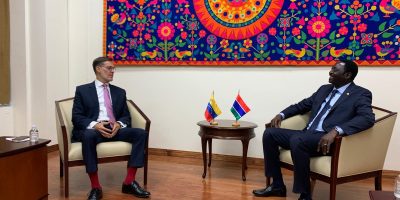By Sarata Jabbi
A Gambian lady based in Norway, Ndey Jobarteh, has published a children’s book. ‘The Rabbit and The Bean Farm’ is the culmination of her long-nurtured aim of contributing to stimulating the literacy skills of children.
Ndey Jobarteh is well-known as Women’s Rights Activist, but that’s only one of her interests – she’s also a Project and Business Developer, a Writer etc. In today’s One to One she talks to us about her book and what inspired her to publish ‘The Rabbit and The Bean Farm’.

The Author
Tell us about yourself?
I am a feminist activist who believe in the rights and bodily integrity of women and girls. I have worked in several management positions in both NGOs, corporate entities, as well as running my own company and a couple of NGOs that I founded. I am a passionate project and business developer. I love innovation and creativity and I see every problem as a new project and innovation. I am a graduate in MBA, Organisation and Management, MSc in Development Studies with Phd Module in Development Studies. I am married with three children, am very passionate about children and draw a lot of inspiration from them.
What is ‘The Rabbit and The Bean Farm about?
It is about a farmer who had a bean farm. Whenever the bean ripened, he would ask his son to look after it before the animals eat them. Unfortunately, the rabbit tricked him so he is distracted and ate almost all the beans. When he was caught, he found a way of escaping by luring the Hyena. The Rabbit and the Hyena is very common in Gambian folktales: The Rabbit as the trickster, who always gets into trouble and always with the Hyena who is always the fool, not very clever. He always get himself in trouble or at other times, in the company of a clever trickster such as Rabbit who profits Hyena’s expense. I love these stories.
What motivates you to produce a book for children?
My first book was on the Inclusion of Women in Peacebuilding in Africa which is also on Amazon.com and I had planned to focus on writing on women issues but as I had my daughter, she started asking me about Africa/Gambia stories. Trying to reduce the pressure I started telling her Gambian folk Tales I remembered and I tried to fine some of these stories in the book shop in Norway but it was difficult to find, was none. So, my daughter asked me to write these stories for her, so that she can be telling them to her class. I did not realise that I had written so many stories for her until one day we were going through the stories and she said Mamma, “I think you should write a book” and she really put pressure on me to write.
I kept on saying “I never wrote children book, I will have to understand it.” She said to me “it is not difficult just put the writings into pictures.” That was how I started, and she supported me in editing the illustrations.
How long did it take you to produce it?
It took 4 intensive months because I already had the stories but it took me a month trying to find an illustrator that will really depict the African scenes and the quality that I wanted but finally I found one.
Did you encounter any challenges in the course of writing and publishing the book?
Yes, as I said I have never written a children’s book before and I have never worked on illustration. So it was very difficult for me to understand how to send or write scenes for the illustrator to understand but I was lucky the illustrator I had took me through the process step by step. Also to make the illustrator understand the African context was also challenging because this was his first time illustrating African stories. This part was the most difficult one and off course the cost of the illustration.
Are there any particular morals the book intends to teach the children?
Yes, when I was told this story as a child all I understood from it was that you should not cheat because anytime you cheat you will be caught and you will get into trouble. So you should always do the right thing and always say the truth.
Are the themes in the book intended for the consumption of Gambian children or for universal consumption?
My first thought was for the children in Norway who had no such books to look at and then after talking to people, I was told that these stories are not made into books in Gambia and it will be good to make it available to the Gambian children.
Where can the book be purchased from?
From Amazon, they are distributing it worldwide.
Do you plan to follow ‘The Rabbit and The Bean Farm up with a sequel?
Yes, the second book will soon come out. I have planned to publish the stories I was told and wrote for my daughter. But the second book will not be the Rabbit, it will be my favourite story that my dad use to tell me when I am stubborn. After that book, the next sequel of the Rabbit will com.
Do you plan to explore other genres of literature other than children’s book?
As I said I have already wrote a book on women and peacebuilding in Africa. I have a manuscript that is not completed as yet on analyses of African women in political participation in Africa.
To what extend is your childhood experience a factor in the writing of this book?
I think it is more of my frustration in finding a book on Gambian/African Folk Talk in Norway for my daughter and the pressure she put on me to publish these stories so that other children can benefit from it
What message do you have for your readers?
I believe that children will enjoy reading it especially with the beautiful illustrations. I hope that they will buy it for their children and also follow the next publications. I also hope that it will encourage and increase the interest in reading for children in the Gambia.
Thank you very much for you time.
You welcome.



Ma sha Allah great and thanks for sharing